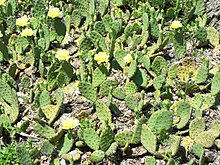Opuntia humifusa
| Eastern prickly pear | |
|---|---|

| |
| Scientific classification | |
| Kingdom: | Plantae |
| Clade: | Tracheophytes |
| Clade: | Angiosperms |
| Clade: | Eudicots |
| Order: | Caryophyllales |
| Family: | Cactaceae |
| Genus: | Opuntia |
| Species: | O. humifusa
|
| Binomial name | |
| Opuntia humifusa (Raf.) Raf.
| |

Opuntia humifusa,commonly knownas thedevil's-tongue,[2]eastern prickly pearorIndian fig,is acactusof the genusOpuntiapresent in parts of theeastern United Statesand northeasternMexico.[3]
Description[edit]
As is the case in otherOpuntiaspecies, the green stems of this low-growingperennialcactus are flattened, and are formed of segments.Barbed bristlesare found around the surfaces of the segments, and longer spines are sometimes present.[4]The flowers are yellow to gold in color, and are found along the margins of mature segments. The flowers are waxy and sometimes have red centers. They measure4–6 cm (1+5⁄8–2+3⁄8in) across. This cactus blooms in the late spring.
The juicy red or purplefruitsmeasure from3–5 cm (1+1⁄8–2 in). As the fruit matures, it changes color from green to red, and often remains on the cactus until the following spring. There are 6 to 33 small, flat, light-coloredseedsin each fruit.
Taxonomy[edit]
Some botanists treat this cactus as a variety ofO. compressa:henceO. c.var.humifusa,or a synonym ofO. compressa.Those recognizing this species treatO. rafinesquiias a junior synonym.
Distribution[edit]
This species naturally occurs along the East Coast of the United States, including on barrier islands from theFlorida Keysto coastalMassachusetts.[5]Eastern prickly pear is found in scattered locations from New Mexico and Montana eastward,[6]and is one of two cactus species native to the eastern United States, along with the relatedO. cespitosa.[7]Since eastern prickly pear grows in hot, sunny locations with thin soil that does not hold water, it is found in shale barrens, which are accumulations of thin, flat, eroded sedimentary rock on steep slopes with southern exposures - essentially a desert microclimate - in the Appalachian Mountains.[8][9]
Habitat[edit]
This plant is very intolerant of shade and instead thrives in sunny, hot and dry environments with well-draining, sandysoil.[10]O. humifusawill grow in open areas in sandy, rocky and coastal scrub habits. It is capable of surviving cool winters unlike many cacti, although harsh winter storms are known to cause habitat loss.[10]
Uses[edit]
The fruits are edible,[11]but have small spiny bristles. The pulp can be scooped and the seeds strained out to make syrup or jelly. The seeds can be briefly roasted and ground into meal.[12]Young cactus segments can be roasted to remove spines, then peeled and sliced to be eaten like string beans; alternatively, they can be deep fried. The leafy segments can be peeled and chewed for emergency hydration.[12]
Opuntia humifasahas also provided traditional medicine uses in Indian, American, Mexican, and Korean cultures.[13]The stem produces an extract that is high in concentrations ofpolyphenolsandflavonoids.It has also been found thatOpuntia humifasahas been associated with endophytic fungi.[14]
Gallery[edit]
-
Fruit in South Carolina
-
Growing wild in coastal habitat, Milford Connecticut
-
Growing wild in northern Illinois (partial shade)
-
Close-up of yellowbarbed bristlesand longer spines
-
Seedling; notice the larger spines
-
Flowers
References[edit]
- ^Majure, L. 2017.Opuntia humifusa(amended version of 2013 assessment). The IUCN Red List of Threatened Species 2017: e.T152374A121591012.https://dx.doi.org/10.2305/IUCN.UK.2017-3.RLTS.T152374A121591012.en.Downloaded on 19 June 2021.
- ^USDA, NRCS(n.d.)."'Opuntia humifusa'".The PLANTS Database (plants.usda.gov).Greensboro, North Carolina: National Plant Data Team.Retrieved23 July2015.
- ^"Opuntia humifusa(Raf.) Raf. "Plants of the World Online.Royal Botanic Gardens, Kew.Retrieved2023-01-26.
- ^"4.Opuntia humifusa",Flora of North America
- ^Eastern Prickly PearOpuntia humifusa(PDF)(Report). Natural Heritage & Endangered Species Program, Massachusetts Division of Fisheries & Wildlife. Archived fromthe original(PDF)on September 21, 2018.
- ^"Opuntia humifusa (Eastern Prickly Pear Cactus) | North Carolina Extension Gardener Plant Toolbox".Plants.ces.ncsu.edu.Retrieved24 June2022.
- ^"Lady Bird Johnson Wildflower Center - The University of Texas at Austin".Wildflower.org.Retrieved24 June2022.
- ^"Cactuses, and the Spine of Appalachia".Carnegie Museum of Natural History.17 July 2018.Retrieved24 June2022.
- ^"Appalachian Shale Barrens"(PDF).Conservationgateway.org.Retrieved24 June2022.
- ^ab"Species Profile (Eastern Prickly Pear Cactus) - Species at Risk Public Registry".Wildlife-species.canada.ca.Retrieved2020-04-15.
- ^Niering, William A.;Olmstead, Nancy C. (1985) [1979].The Audubon Society Field Guide to North American Wildflowers, Eastern Region.Knopf. p. 436.ISBN0-394-50432-1.
- ^abElias, Thomas S.; Dykeman, Peter A. (2009) [1982].Edible Wild Plants: A North American Field Guide to Over 200 Natural Foods.New York:Sterling.p. 139.ISBN978-1-4027-6715-9.OCLC244766414.
- ^Sharma, Bhesh Raj; Park, Chul Min; Won Choi, Jong; Rhyu, Dong Young (2017)."Anti-nociceptive and anti-inflammatory effects of the methanolic extract ofOpuntia humifusastem ".Avicenna Journal of Phytomedicine.7(4): 366–375.PMC5580874.PMID28884086.
- ^"Diversity and antifungal activity of the endophytic fungi associated with the native medicinal cactusOpuntia humifusa(Cactaceae) from the United States ".Microbiological Research.175:67–77. 2015.doi:10.1016/j.micres.2015.03.007.







